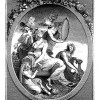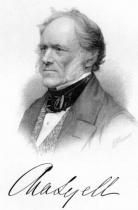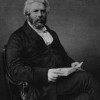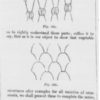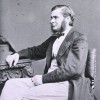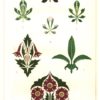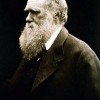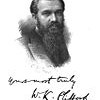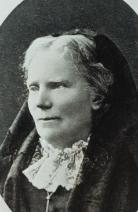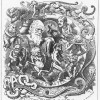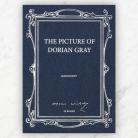test
Created by Dino Franco Felluga on Tue, 08/31/2021 - 11:54
Part of Group:
test
Timeline
Chronological table
| Date | Event | Created by | Associated Places | |
|---|---|---|---|---|
| 187 |
Christopher Dresser, Principles of Decorative DesignChristopher Dresser publishes Principles of Decorative Design. ArticlesIrena Yamboliev, “Christopher Dresser, Physiological Ornamentist” Related ArticlesMorna O’Neill, “On Walter Crane and the Aims of Decorative Art” Wendy S. Williams, "‘Free-and-Easy,’ ‘Japaneasy’: British Perceptions and the 1885 Japanese Village" Siobhan Carroll, "On Erasmus Darwin’s The Botanic Garden, 1791-1792" |
Dave Rettenmaier | ||
| Jun 1792 |
Botanic Garden
ArticlesSiobhan Carroll, “On Erasmus Darwin’s The Botanic Garden, 1791-1792″ |
Dave Rettenmaier | ||
| Jan 1830 |
Publication of Charles Lyell's Principles of GeologyJanuary 1830 saw the publication of the first volume (of three) of Charles Lyell’s Principles of Geology. Lyell’s work, though contested, establishes the preeminence of Uniformitarian principles in the interpretation of Geological phenomena, and allows vast temporal scope for Charles Darwin’s subsequent model of evolutionary development.
image courtesy of wikipedia: https://en.wikipedia.org/wiki/File:Charles_Lyell00.jpg |
Michaela Jensen | ||
| 1 Jan 1830 |
Principles of Geology
Lyell’s work, though contested, establishes the preeminence of Uniformitarian principles in the interpretation of Geological phenomena, and allows vast temporal scope for Charles Darwin’s subsequent model of evolutionary development. ArticlesMartin Meisel, "On the Age of the Universe" Related ArticlesNancy Armstrong, “On Charles Darwin’s The Descent of Man, 24 February 1871″ Ian Duncan, “On Charles Darwin and the Voyage of the Beagle” Anna Henchman, “Charles Darwin’s Final Book on Earthworms, 1881” Cannon Schmitt, “On the Publication of Charles Darwin’s On the Origin of Species, 1859″ |
Dave Rettenmaier | ||
| Oct 1831 to Oct 1836 |
Darwin's voyage on the Beagle
ArticlesNancy Armstrong, “On Charles Darwin’s The Descent of Man, 24 February 1871″ Ian Duncan, “On Charles Darwin and the Voyage of the Beagle” Anna Henchman, “Charles Darwin’s Final Book on Earthworms, 1881” Cannon Schmitt, “On the Publication of Charles Darwin’s On the Origin of Species, 1859″ Related ArticlesDaniel Bivona, “On W. K. Clifford and ‘The Ethics of Belief,’ 11 April 1876″ |
Dave Rettenmaier | ||
| Oct 1844 |
Vestiges of the Natural History of Creation
ArticlesJonathan Smith, “The Huxley-Wilberforce ‘Debate’ on Evolution, 30 June 1860″ Related ArticlesNancy Armstrong, “On Charles Darwin’s The Descent of Man, 24 February 1871″ Ian Duncan, “On Charles Darwin and the Voyage of the Beagle” Anna Henchman, “Charles Darwin’s Final Book on Earthworms, 1881” Martin Meisel, "On the Age of the Universe" Cannon Schmitt, “On the Publication of Charles Darwin’s On the Origin of Species, 1859″ Daniel Bivona, “On W. K. Clifford and ‘The Ethics of Belief,’ 11 April 1876″ |
Dave Rettenmaier | ||
| Jan 1857 to Dec 1858 |
Christopher Dresser, “Botany as Adapted to the Arts and Art-Manufacture”
Image: Christopher Dresser, nature’s diaper patterns, from “Botany as Adapted to the Arts and Art-Manufacture” (1857-1858). Public domain. ArticlesIrena Yamboliev, “Christopher Dresser, Physiological Ornamentist” Related ArticlesWendy S. Williams, "‘Free-and-Easy,’ ‘Japaneasy’: British Perceptions and the 1885 Japanese Village" Siobhan Carroll, "On Erasmus Darwin’s The Botanic Garden, 1791-1792" |
Dave Rettenmaier | ||
| 24 Nov 1859 |
On the Origin of Species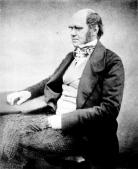 "Charles Darwin, aged 51." According to the son of Charles Darwin, Francis Darwin, this portrait is by Messrs. Maull and Fox. Photo is in the public domain. On 24 November 1859, Charles Darwin publishes his On the Origin of Species by Means of Natural Selection. This book introduced the theory of evolution--species evolve over time through the process of natural selection. These theories were highly controversial because they conflicted with many of the prevelant theologial beliefs of the time. |
Griffin Kerr | ||
| 24 Nov 1859 to 24 Nov 1859 |
On the Origin of SpeciesPublication of Charles Darwin’s On the Origin of Species: Or the Preservation of Favoured Races in the Struggle for Life. Image. "Charles Darwin, on the Origin of Species. London: John Murray, 1859. Articles |
Dave Rettenmaier | ||
| 24 Nov 1859 |
On the Origin of Species
ArticlesNancy Armstrong, “On Charles Darwin’s The Descent of Man, 24 February 1871″ Ian Duncan, “On Charles Darwin and the Voyage of the Beagle” Anna Henchman, “Charles Darwin’s Final Book on Earthworms, 1881” Martin Meisel, "On the Age of the Universe" Cannon Schmitt, “On the Publication of Charles Darwin’s On the Origin of Species, 1859″ Related ArticlesDaniel Bivona, “On W. K. Clifford and ‘The Ethics of Belief,’ 11 April 1876″ |
Dave Rettenmaier | ||
| 1860 |
Essays and ReviewsThe publication in March 1860 of the seven articles by liberal Anglicans comprising Essays and Reviews set off a firestorm of controversy within the Church of England and across British society. The “seven against Christ,” as they were called by their critics, embraced a Christianity in step with the new historical scholarship of the Bible and with modern science. ArticlesJonathan Smith, “The Huxley-Wilberforce ‘Debate’ on Evolution, 30 June 1860″ Related ArticlesIan Duncan, “On Charles Darwin and the Voyage of the Beagle” Anna Henchman, “Charles Darwin’s Final Book on Earthworms, 1881” Martin Meisel, "On the Age of the Universe" Cannon Schmitt, “On the Publication of Charles Darwin’s On the Origin of Species, 1859″ Daniel Bivona, “On W. K. Clifford and ‘The Ethics of Belief,’ 11 April 1876″ |
Dave Rettenmaier | ||
| 30 Jun 1860 |
Huxley-Wilberforce “Debate” on Evolution
ArticlesJonathan Smith, “The Huxley-Wilberforce ‘Debate’ on Evolution, 30 June 1860″ Related ArticlesNancy Armstrong, “On Charles Darwin’s The Descent of Man, 24 February 1871″ Ian Duncan, “On Charles Darwin and the Voyage of the Beagle” Anna Henchman, “Charles Darwin’s Final Book on Earthworms, 1881” Martin Meisel, "On the Age of the Universe" Cannon Schmitt, “On the Publication of Charles Darwin’s On the Origin of Species, 1859″ Daniel Bivona, “On W. K. Clifford and ‘The Ethics of Belief,’ 11 April 1876″ |
Dave Rettenmaier | ||
| 1862 |
Christopher Dresser, The Art of Decorative Design
Image: Plate II from Dresser, The Art of Decorative Design (1862). Courtesy of the Department of Special Collections, Stanford University Libraries. ArticlesIrena Yamboliev, “Christopher Dresser, Physiological Ornamentist” Related ArticlesMorna O’Neill, “On Walter Crane and the Aims of Decorative Art” Wendy S. Williams, "‘Free-and-Easy,’ ‘Japaneasy’: British Perceptions and the 1885 Japanese Village" Siobhan Carroll, "On Erasmus Darwin’s The Botanic Garden, 1791-1792" |
Dave Rettenmaier | ||
| 1869 |
The Edinburgh Seven enrolled at the University of EdinburghThe Edinburgh Seven were the first seven girls that were allowed to enroll at a British university. While the university did not let them graduate in the end, their case did generate a lot of national attention, including that of Charles Darwin. |
Cooper Gollier | ||
| 24 Feb 1871 |
Descent of Man
ArticlesNancy Armstrong, “On Charles Darwin’s The Descent of Man, 24 February 1871″ Related ArticlesIan Duncan, “On Charles Darwin and the Voyage of the Beagle” Anna Henchman, “Charles Darwin’s Final Book on Earthworms, 1881” Cannon Schmitt, “On the Publication of Charles Darwin’s On the Origin of Species, 1859″ |
Dave Rettenmaier | ||
| 11 Apr 1876 |
"Ethics of Belief"
ArticlesDaniel Bivona, “On W. K. Clifford and ‘The Ethics of Belief,’ 11 April 1876″ Related ArticlesNancy Armstrong, “On Charles Darwin’s The Descent of Man, 24 February 1871″ Ian Duncan, “On Charles Darwin and the Voyage of the Beagle” Anna Henchman, “Charles Darwin’s Final Book on Earthworms, 1881” Bernard Lightman, “On Tyndall’s Belfast Address, 1874″ Martin Meisel, “On the Age of the Universe” Cannon Schmitt, “On the Publication of Charles Darwin’s On the Origin of Species, 1859″ |
Dave Rettenmaier | ||
| 11 Aug 1876 to 11 Aug 1876 |
The Medical Act of 1876The Medical Act of 1876 The 1870s was one of the most important decades for British women in the field of medicine. Perhaps the most prominent act was the Medical Act of 1876. The act allowed all British medical authorities to license all qualified applicants, regardless of gender. Prior to the Medical Act of 1876, women practiced as unlicensed physicians, a phenomenon that was not uncommon for both men and women at the time (Kirwan). The Medical Act of 1858, however, set laws to regulate unlicensed physicians in the United Kingdom. Although this act might sound justified, it was unfair to women who wanted to practice, but could not, due to medical schools refusing to accept women to their establishments. The act did not stop one particularly brilliant woman, Dr. Elizabeth Blackwell, who had found a loophole in the Medical Acts. She realized that British laws did not prevent foreign practicing doctors from practicing in the United Kingdom. Dr. Blackwell had already graduated from New York’s Geneva Medical college in 1849, becoming the first woman to earn an M.D. degree in the United States. She used her medical degree to register in the General Medical Council of Britain (Jefferson et al.). She was allowed to practice in 1865, when she was granted entry to the Society of Apothecaries (Wagner). The Society of Apothecaries prevented future female entrants later that year. A group of women who got expelled from Edinburgh University decided to work their way around the established medical schools that did not accept women into their programs by founding the London School of Medicine for Women in 1874. Among those women was Dr. Elizabeth Blackwell. The London School of Medicine for Women began in a small house but moved to purpose-built premises at the end of the 19th century. The students were taught by male doctors who supported their cause. The school was noted for its international links to other medical establishments. Despite the foundation of the London School of Medicine for Women, many ambitious women in Britain were not pleased with the prominent medical schools that still held the belief that women were not fit to practice medicine. The Edinburgh Seven, who were the same seven women that established the London School of Medicine for Women, led the campaign to fight the persistent inequality in medical schools. Those women were expelled from their medical program due to increasing hostility from male professors despite their gaining honors in multiple subjects. Their campaign gained them many renowned supporters, such as Charles Darwin. Despite the campaign’s publicity, the Court of Session supported the University’s right to reject giving degrees to women and ruled that the seven women should not have been allowed to join the medical program in the first place. The failed campaign, however, gained enough support to eventually result in the Medical Act of 1876. The Medical Act of 1876 was proposed by Parliament member Russell Gurney. Theoretically, the act should have allowed women access to medical schools. The act, however, did not enforce the acceptance of women in medical schools. It only allowed medical schools to choose whether or not they wanted to accept women into their medical programs. Most medical schools at the time continued to reject all female applicants to their schools. The Royal College of Physicians did not admit women into their programs until 1907 (British Medical Journal). Furthermore, the act did not enforce any laws for equal treatment of women if they were to be accepted into medical programs. The struggle for women who sought a medical career continued well into the 20th century.
Works Cited Jefferson, Laura, et al. “Women in Medicine: Historical Perspectives and Recent Trends.” OUP Academic, Oxford University Press, 8 Mar. 2015, academic.oup.com/bmb/article/114/1/5/246075. Wagner, John A. “Voices of Victorian England: Contemporary Accounts of Daily Life.” Google Books, ABC-CLIO, 25 Feb. 2014, books.google.com/books?id=VqiSAwAAQBAJ. “Former London School of Medicine for Women.” Historic England, historicengland.org.uk/research/inclusive-heritage/womens-history/women-and-healthcare/former-london-school-of-medicine-for-women/. “British Medical Journal.” Google Play, Google, 1908, play.google.com/books/reader?id=1Rw-AQAAMAAJ.
|
Laith Shaban | ||
| 10 Oct 1881 |
Darwin, The Formation of Vegetable Mould, through the Action of Worms
ArticlesAnna Henchman, “Charles Darwin’s Final Book on Earthworms, 1881” Related ArticlesNancy Armstrong, “On Charles Darwin’s The Descent of Man, 24 February 1871″ Daniel Bivona, “On W. K. Clifford and ‘The Ethics of Belief,’ 11 April 1876″ Ian Duncan, “On Charles Darwin and the Voyage of the Beagle” Martin Meisel, "On the Age of the Universe" Cannon Schmitt, “On the Publication of Charles Darwin’s On the Origin of Species, 1859″ |
Dave Rettenmaier | ||
| 19 Apr 1882 |
Death of Charles Darwin
Related ArticlesNancy Armstrong, “On Charles Darwin’s The Descent of Man, 24 February 1871″ Ian Duncan, “On Charles Darwin and the Voyage of the Beagle” Anna Henchman, “Charles Darwin’s Final Book on Earthworms, 1881” Martin Meisel, "On the Age of the Universe" Cannon Schmitt, “On the Publication of Charles Darwin’s On the Origin of Species, 1859″ Jonathan Smith, “The Huxley-Wilberforce ‘Debate’ on Evolution, 30 June 1860″ Daniel Bivona, “On W. K. Clifford and ‘The Ethics of Belief,’ 11 April 1876″ |
Dave Rettenmaier | ||
| Jul 1890 |
(1890) "The Picture of Dorian Gray" by Oscar WildeIn the article "Aestheticism, Homoeroticism, and Christian Guilt in the Picture of Dorian Gray," Lewis Carroll constructs an argument that relates Oscar Wilde's The Picture of Dorian Gray to the contemporary converstaions of Darwinism, negative reception towards homoeroticism, and the realization of Christian guilt. The argument of the article itself shows how literary criticism evolved from ignoring and even despising novels to later creating historical arguments using novels as their evidence. Carroll links the novel's subject matter to the historical intellectual movements of the late 19th century. In the article, Carroll claims that The Picture of Dorian Gray pushes back against Darwinian criticism in two ways. First, the homoerotic relationships presented in the novel contradict Darwin's idea of mating for reproduction. Secondly, the primary conflict in the novel opposes the "quasi-Darwinian conceptual strucutre implicit in most realist and naturalist fiction" (Carroll 287). Earlier in the history of the novel, novels would likely not receive such regard to be compared to historical movements. Carroll, Joseph. "AESTHETICISM, HOMOEROTICISM, AND CHRISTIAN GUILT IN THE PICTURE OF DORIAN GRAY." Philosophy and Literature, vol. 29, no. 2, 2005, pp. 286-304. ProQuest, http://pointloma.idm.oclc.org/login?url=https://www-proquest-com.pointlo.... |
Shane Hoyle |

